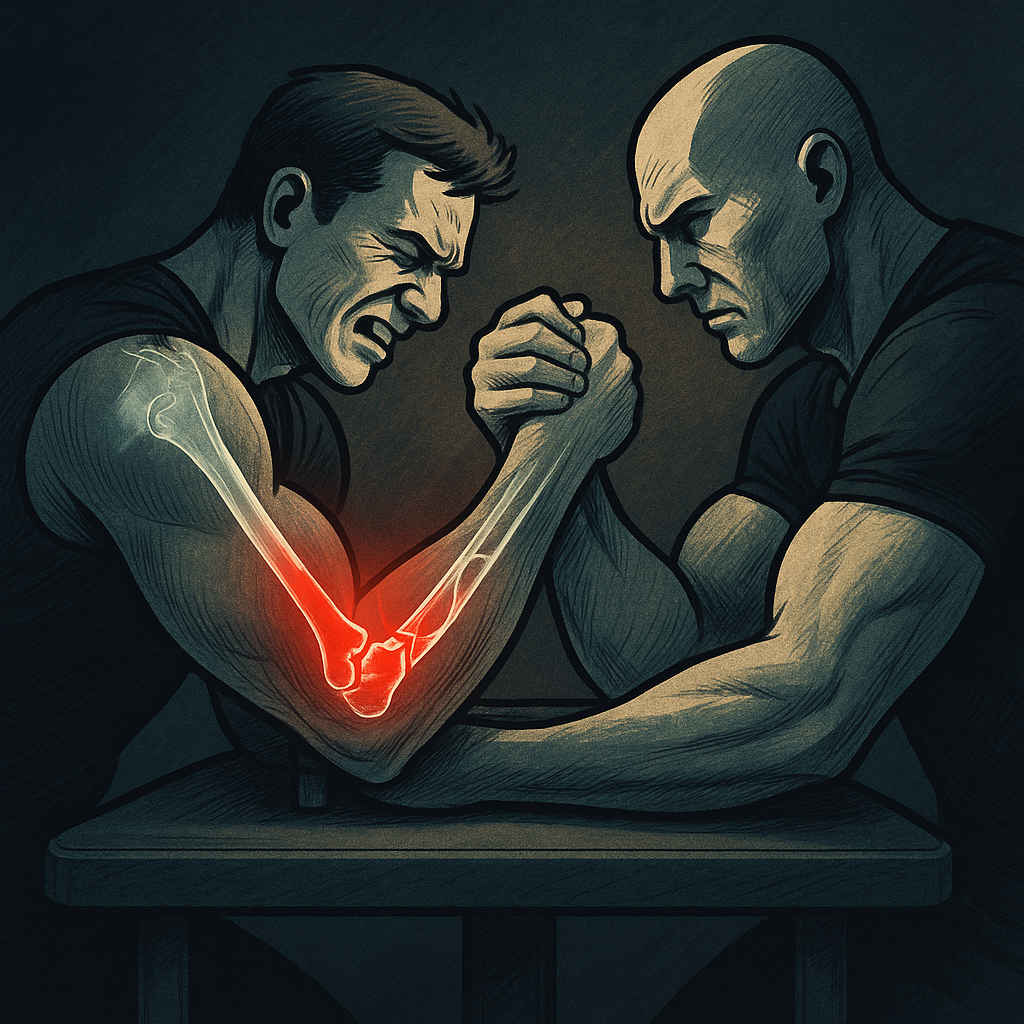Table of Contents
1. The Anatomy of an Arm‑Wrestling Break
What actually breaks?
Nearly 9 in 10 serious arm‑wrestling injuries are spiral fractures of the distal humerus. The upper arm bone fails when a large torsional force (rotation) collides with a bending force (your opponent’s side pressure) while the shoulder internally rotates.
Why it happens biomechanically
| Force | Explanation | How it builds up |
|---|---|---|
| Torsion | Your shoulder turns inward while your hand is stuck in place | Twisting to “finish the pin” too early |
| Bending (valgus) | Your elbow drifts outside your shoulder line | “Open‑arm” position or losing center |
| Compression | Both competitors drive downward | Heavy side press without tight structure |
When bone, connective tissue, and muscle strength can’t offset those three forces simultaneously, the humerus spirals and snaps.
2. Major Causes of an Arm Break
| Rank | Cause | Tell‑tale sign |
|---|---|---|
| 1 | Poor elbow‑to‑shoulder alignment | Upper arm “floats” away from the torso |
| 2 | Rotating the torso before your hand is winning the hand fight | You “look away” from your hand |
| 3 | Fatigue‑induced technique breakdown | Forearm shakes, elbow slips |
| 4 | Zero warm‑up or cold starts | You hop on the table “just for fun” |
| 5 | Strength imbalances (rotator cuff & brachialis) | Over‑dominant biceps, weak stabilisers |
| 6 | Arm‑wrestling on makeshift surfaces (bar top, kitchen table) | Elbow pad too small or slippery |
3. Proven Strategies to Stay Safe
3.1 Master “Closed‑Arm” Technique
-
Keep your hand, wrist, and elbow inside your shoulder line.
-
Drag, don’t press until you’ve secured hand control.
-
Eyes on your hand – if you’re looking away, you’re twisting the humerus.
3.2 Build a Bulletproof Support Chain
| Region | Must‑strengthen muscles | Best exercises* |
|---|---|---|
| Forearm flexors & pronators | Pronator teres, flexor digitorum profundus | Armwrestling Judo Belt, Popeye's Pronator, Wrist Wrench |
| Brachialis & brachioradialis | Elbow flexion under supination | Thick‑Grip Hammer Curls, Reverse Curls |
| Rotator cuff | Infraspinatus, subscapularis | External‑rotation band work, Kettlebell bottoms‑up carry |
| Scap stabilisers | Lower traps, serratus | Scap pull‑ups, face pulls |
3.3 Adopt a Competition‑Grade Warm‑Up (see next section)
3.4 Respect Fatigue
If hand & wrist control fades, stop. Fatigue reduces reaction time and positional awareness → higher twist‑torque spikes.
3.5 Educate Training Partners
Most breaks occur in casual settings. A 60‑second safety brief before a sparring session lowers injury risk for everyone.
4. Recommended Warm‑Up & Strength Plan
Pre‑Table Warm‑Up (5–7 min)
-
2 min light cardio → raise core temp
-
Rice Bucket Circles × 2 sets × 20 reps each direction
-
Band External‑Rotations × 15
-
Isometric Wrist Curls against band resistance × 10‑sec holds
-
3–4 light ready‑go pulls with 30 % effort, focus on elbow‑in posture
5. Equipment & Environment Checklist
-
Regulation arm‑wrestling table with 7” × 7” elbow pads
-
Dry, non‑glossy elbow pads + liquid chalk → zero slip
-
Flat, grippy shoes and solid foot blocks
-
No matches on bars, uneven counters, or while standing on unstable surfaces
-
Use competition straps only to prevent slipping—not as a crutch for poor form
6. What to Do If You Suspect a Break
-
Stop immediately – even if pain is minimal.
-
Immobilise the arm in the position found.
-
Ice & elevate while awaiting emergency services.
-
Seek an X‑ray; spiral fractures often require surgery + plate fixation.
-
Rehab patiently: 10–16 weeks typical; start with passive ROM, progress to light pronation/supination, then loaded grips.
7. FAQ
Q 1: How common are arm breaks in armwrestling?
A controlled‑event study in 2023 estimated ~0.5 % of competitive matches end in fractures; backyard pulls are multiples higher due to poor tables and technique.
Q 2: Can lifting weights prevent an arm break?
Stronger bones and connective tissue help absorb torsion, but correct technique is even more important. Combine both for best protection.
Q 3: Is using a strap safer?
Straps stop hand slips but do not reduce humeral torque. You still need tight elbow‑in posture.
Q 4: What’s the fastest way to return after a fracture?
Early medical care, rigid fixation, and gradual isometric forearm work. Check out our upcoming Wrist & Elbow Bulletproofing course for a phased rehab blueprint.
8. Key Takeaways
-
Arm breaks = spiral humerus fractures caused by a combination of endoration of the shoulder and exorotation of the upper arm
-
Technique first: keep elbow inside shoulder, eyes on hand, torso square.
-
Strengthen the chain with targeted pronation, supination, and rotator‑cuff work (Golden Grip has tools for each).
-
Warm up properly and pull only on regulation tables.
-
If pain or “pop” happens, immobilise, ice, X‑ray, rehab.


